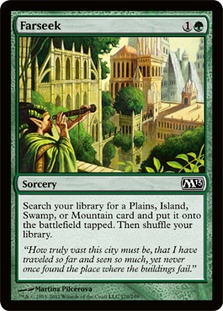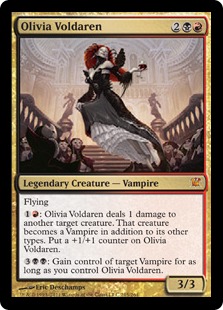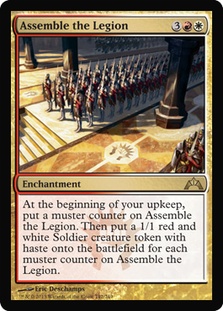That awkward feeling when the deck you’ve chosen for an important tournament is nowhere to be seen…
Magic Online Daily Events? Nope. SCG Open Top 16s? Nada.
Once a week, one player makes the Top 8 of a Magic Online Premier Event with it and then disappears for another week.
You chose your deck wisely, but this inexistence accompanied with weekly shots creates so many questions. Why does no one play the deck? Yes, it’s rare, but it’s well known. And it’s strange that Bant Hexproof and even Bant Delver are more popular than your choice. If the deck is bad, how good must the player making Top 8s with it in Premier Events be? If the deck is actually fine, why has no one tried it after seeing it Top 8 Premier Events?
You chose your deck wisely because you feel it will be well positioned in the eventual metagame state and you’ve done your best adapt it to that. But you still have so many questions in your head—and so few answers.
Three days before the tournament—the key point when it’s not too late to change horses before the race. You’re in a panic and are almost ready to switch, but two well-known writers independently say that your choice would be interesting right now.
Your brain explodes.
The player who made Top 8 of Premier Events three weeks in a row with the same 75 is rex51515, and his deck is Human Reanimator.
Creatures (18)
- 4 Fiend Hunter
- 2 Huntmaster of the Fells
- 4 Angel of Glory's Rise
- 4 Burning-Tree Emissary
- 4 Undercity Informer
Lands (22)
Spells (20)
Sideboard

The downsides of the deck are clear—it’s simply less powerful than G/B/W Reanimator and is more vulnerable to graveyard hate since its creatures are worse and its combo is more complicated. So why should you play Human Reanimator now when hate is on the rise?
First, the deck is favored in the quasi-mirror against G/B/W Reanimator. That’s debatable because it requires careful play from Human Reanimator player, but the matchup is positive for the well-trained player. You’ll also be spared from hearing, “I don’t want to play that stupid Junk mirror anymore.”
Second, Human Reanimator is much better against novel anti-Reanimator plans like Izzet Staticaster plus Clone and Turbo Fog. G/B/W Reanimator becomes worse as opponents shift from graveyard hate to other plans, while Human Reanimator is able to capitalize on this shift.
Third, Human Reanimator seems to be much better positioned against Esper Control, which is on the rise right now. It’s still hard to play against Rest in Peace, but they rarely have more than two and one is very beatable.
And one more point for overall cuteness goes to Angel of Glory’s Rise for the first part of her second ability—I actually expected a nonzero quantity of Zombies at my tournament.
The problems with Human Reanimator that we must solve are the Naya Blitz matchup, which is even worse than Junk’s, and the exact implementation of anti-hate plans, including a plan against Slaughter Games. The deck isn’t great as a generic midrange deck, but it must sideboard into it from time to time. Both problems call for maindeck Huntmaster of the Fells over, for example, Avacyn’s Pilgrim, and the mana base is complicated enough to require some Farseeks to work properly so I didn’t find a reason to avoid them.
Creatures (21)
- 4 Fiend Hunter
- 3 Huntmaster of the Fells
- 4 Angel of Glory's Rise
- 2 Deathrite Shaman
- 4 Burning-Tree Emissary
- 4 Undercity Informer
Lands (22)
Spells (17)
Sideboard

The mana base is a little bit rough since I decided to run twelve shocklands, but Dragonskull Summit wouldn’t work instead of Blood Crypt because it would come into play tapped too often. From the other side, one of the Woodland Cemeterys would probably be a Clifftop Retreat. Some builds I saw had 23 lands, but I think that 22 plus Farseek plus Deathrite Shaman is enough. The main problem of the mana base is that all the maindeck white cards cost double white; luckily, Cavern of Souls helps, but remember to consider white if you tweak the deck’s mana.
Deathrite Shaman maindeck is a concession to the quasi-mirror match and the increased amount of control decks. It’s also a chump blocker from time to time and fine mana stabilization when you need to cast something complicated. I’m not really sure about Shaman; it could easily be a land plus Mulch or a pair of Abrupt Decays. However, Decay is worse in game 1 than post-board, while Shaman is always fine to have.
The sideboard includes cards for aggro, control, and hate. The last is especially important against Slaughter Games since Human Reanimator doesn’t have a variety of threats and can’t simply punish opponent for early tempo loss with turn 3 or turn 4 games. I tried different combinations and finally discovered Olivia Voldaren as a card that shines against nearly any opponent—especially when unexpected.
The typical sideboard plan against aggro decks includes a ton of life gain and Rhox Faithmender, but it could easily be too slow against Naya Blitz so early removal seems better to me. Four Abrupt Decays are obvious, and the rest is the subject to change. I’d be happy to have some one-mana removal to complement Decay, but nothing beats a big Champion of the Parish. The deck’s mana is much better at casting turn 2 spells, so I finally settled on two Mizzium Mortars. Overload’s advantage over Ultimate Price is marginal, but the ability to cast Burning-Tree Emissary into removal is relevant.
Another removal card I strongly considered was Sever the Bloodline, but it’s mostly for midrange and G/B/W Reanimator and is too slow against aggro. Some players also use Rolling Temblor (rex51515’s list), but it’s irrelevant against the actual sizes of Champion of the Parish and Frontline Medic, so I finally cut it.
Thragtusk and Olivia Voldaren finish the anti-aggro package. My board isn’t really optimal here as I never side in all six cards. I usually leave one Olivia in the board against faster aggro and one Beast against slower ones (like Zombies of Jund Aggro), so the third Olivia may be better off as Sever the Bloodline or even something like Gisela, Blade of Goldnight if you care about matchups like Jund.
I don’t really like Thragtusk against midrange decks because it’s hard to win Tusk wars when you have much less relevant removal and other threats, so I prefer staying on the combo plan here and sideboarding only to provide plan B against hate. Appropriate cards are Olivia Voldaren and Assemble the Legion, which come in depending on the matchup. The weak spot of this combination is U/W/R since both Olivia and Assemble are weak due to bounce and Izzet Staticaster, respectively. However, Assemble may still be good because Izzet Staticaster is weak against our other cards and they might not sideboard it in.
Zealous Conscripts is for control decks. The deck’s ability to win on the spot and without dealing combat damage is its major upside. However, both Esper Control and Turbo Fog play Witchbane Orb, preventing you from milling them out. Winning through combat damage may be hard, so the solution is to mill yourself and somehow abuse it. Reanimating Acidic Slime or any other non-Human creature isn’t possible since you’ll probably have no white or black mana to cast Unburial Rites.
Manic Vandal isn’t legal in Standard, so Zealous Conscripts and Laboratory Maniac are the only two realistic ways to win. Maniac is much cooler, but Conscripts is better outside of the exact “combo vs. orb” position. Stealing and sacrificing Thragtusk is fine, and stealing a ready-to-ultimate planeswalker is awesome.
So the generic sideboard plan against aggressive decks is the following:
+4 Abrupt Decay
+2 Mizzium Mortars
+3 Thragtusk
+2 Olivia Voldaren
-2 Faithless Looting
-2 Grisly Salvage
-1 Mulch
-2 Undercity Informer
-2 Unburial Rites
-2 Angel of Glory’s Rise
The combo isn’t really needed here, but Unburial Rites will still have some sweet targets like Huntmaster of the Fells and Thragtusk. Angel of Glory’s Rise can sometimes save you in really tough situations, so I prefer to keep it in too. You can, however, take out both Angels and side in the last Olivia, but since some graveyard-filling cards are still in, being able to use them profitably is sweet, even if the main modes of Mulch are “put Grisly Salvage, Mulch, Farseek, and Abrupt Decay into the graveyard” and “put four lands into hand for exactly seven; you’ve mulliganed and are thus unable to discard the Angel and Rites you’ve topdecked.”
The plan changes slightly against slower aggro decks like R/G Aggro, The Aristocrats, and Zombies because Olivia Voldaren is better there (and don’t sideboard out Angel against Zombies), but it’s generally the same.
The plan against G/B/W Reanimator is even simpler: plus three Olivia Voldaren, minus Huntmaster of the Fells, Faithless Looting, and Burning-Tree Emissary. Your combo is the primary way to win, so the goal is to assemble it faster than you’ll die from Craterhoof Behemoth. In other cases, you have Olivia Voldaren to deal with Angel of Serenity and lesser threats in the long game.
The opponent’s primary plans are probably Craterhoof Behemoth (you’re also badly positioned against Lingering Souls if you don’t draw Olivia) and recurring Acidic Slime to prevent you from playing the game of Magic. Both plans presume the opponent would win the late game, so try to be as fast as possible in going off. I also leave some Huntmaster of the Fells in to help survive against Acidic Slime / Thragtusk beatdown.
Plans against different midrange decks include some amount of Abrupt Decay depending on their graveyard hate (more against Rest in Peace decks, less against Jund, etc.) and a mix of Olivia Voldaren, Assemble the Legion, and Thragtusk. The last one is actually unlikely to come in. Don’t try to win fair in a midrange vs. midrange battle—go combo. You want to side out Deathrite Shamans and some combo pieces (the games go longer, so three copies of each one is usually fine).
All U/W control decks normally rely on Rest in Peace, so the sideboard plan is all Abrupt Decays, Zealous Conscripts against Witchbane Orb, and Assemble the Legion as a backup plan. Boarding out is similar to midrange decks (one copy of most combo pieces), but you may try sideboarding out all the Huntmasters and trying to go all-in combo or, more accurately, unexpected combo through an end of turn Grisly Salvage and/or Undercity Informer plus discard from Faithless Looting. Control opponents often hold graveyard hate in their hand to avoid Abrupt Decay, so try to punish them for it. However, the most realistic way to combo is still Cavern of Souls set on Angel.
Overall, the deck is well positioned against any non-Blitz opponent and has some advantages in key matchups, so it deserves more attention than it has now despite having problems with the power level of its cards and the quantity of cards in its combo. The top lists from the StarCityGames.com Invitational and Standard Open in Atlanta seem to be a fine metagame for the deck, and I definitely hope it will do well soon.
Good luck to everyone playing!






